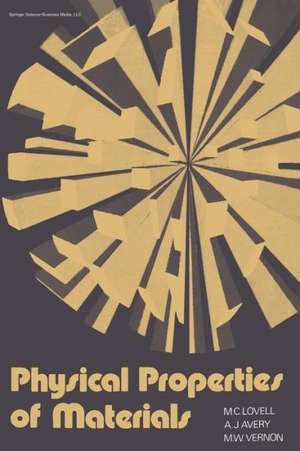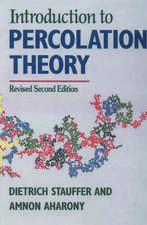Physical Properties of Materials: The Modern University in Physics Series
Autor M. C. Lovellen Limba Engleză Paperback – 31 dec 1976
Preț: 641.85 lei
Preț vechi: 755.13 lei
-15% Nou
Puncte Express: 963
Preț estimativ în valută:
122.86€ • 133.49$ • 103.27£
122.86€ • 133.49$ • 103.27£
Carte tipărită la comandă
Livrare economică 21 aprilie-05 mai
Preluare comenzi: 021 569.72.76
Specificații
ISBN-13: 9780442300975
ISBN-10: 0442300972
Pagini: 304
Ilustrații: XII, 304 p.
Dimensiuni: 155 x 235 x 18 mm
Greutate: 0.46 kg
Editura: SPRINGER NETHERLANDS
Colecția Springer
Seria The Modern University in Physics Series
Locul publicării:Dordrecht, Netherlands
ISBN-10: 0442300972
Pagini: 304
Ilustrații: XII, 304 p.
Dimensiuni: 155 x 235 x 18 mm
Greutate: 0.46 kg
Editura: SPRINGER NETHERLANDS
Colecția Springer
Seria The Modern University in Physics Series
Locul publicării:Dordrecht, Netherlands
Public țintă
ResearchCuprins
1 Fundamentals.- 1.1 Introduction.- 1.2 Wave mechanics.- 1.4 Transition elements.- 1.5 Atomic magnetism.- 1.6 Electrons in solids.- 2 Structure of Solids.- 2.1 Introduction—atomic bonding.- 2.2 Crystal structure.- 2.3 Lattice planes and directions.- 2.4 Atomic packing.- 2.5 Covalent solids.- 2.6 Ionic solids.- 2.7 Summary.- 2.8 Lattice imperfections.- 2.9 Lattice vibrations.- 2.10 Point defects.- 2.11 Line defects.- 2.12 Plane defects.- 2.13 Amorphous materials.- 3 Preparation of Materials.- 3.1 Introduction.- 3.2 Mechanism of crystal growth.- 3.3 Growth from the melt.- 3.4 Non-melt techniques.- 3.5 Thin films.- 3.6 The origin of dislocations during crystal growth.- 3.7 Non-crystalline materials.- 3.8 Amorphous semiconductors.- 3.9 Plastic materials.- 4 Practical Determination of Structure.- 4.1 Introduction.- 4.2 Theoretical X-ray diffraction.- 4.3 Practical X-ray diffraction.- 4.4 Other applications of X-ray diffraction.- 4.5 Neutron diffraction.- 4.6 Electron diffraction.- 4.7 Structure of amorphous materials.- 4.8 Other techniques.- 5 Mechanical Properties of Materials.- 5.1 Introduction.- 5.2 Mechanical testing.- 5.3 Elastic behaviour.- 5.4 Plastic behaviour.- 5.5 Fracture.- 5.6 Strengthening of materials.- 5.7 Creep.- 5.8 Mechanical properties of plastics.- 6 Thermal Properties.- 6.1 Introduction.- 6.2 Thermal statistics.- 6.3 Heat capacity.- 6.4 Specific heat anomalies.- 6.5 Thermal expansion.- 6.6 Thermal conductivity.- 6.7 Thermoelectricity.- 7 Electrical Properties.- 7.1 Introduction.- 7.2 Metals.- 7.3 Semiconductors.- 7.4 Transition metal compounds.- 7.5 Polarons.- 7.6 Magnetic semiconductors.- 7.7 Amorphous materials.- 7.8 Switching.- 8 Dielectrics.- 8.1 Introduction.- 8.2 Mechanisms of polarization.- 8.3 The local field.- 8.4 The Clausius-Mosottirelation.- 8.5 Dielectric relaxation.- 8.6 Applications.- 8.7 Piezoelectric, pyroelectric and ferroelectric materials.- 8.8 Piezoelectricity.- 8.9 Ferroelectricity.- 8.10 Classification of ferroelectric materials.- 8.11 Barium titanate.- 8.12 Ferroelectric ceramics.- 8.13 Ferroelectric domains.- 8.14 Pyroelectricity.- 9 Magnetic Properties.- 9.1 Introduction.- 9.2 Classification of magnetic materials.- 9.3 Diamagnetism.- 9.4 Paramagnetism 187 9.4.1 Pauli paramagnetism.- 9.5 Ferromagnetism.- 9.6 Magnetic anisotropy.- 9.7 Magnetostriction.- 9.8 Ferromagnetic domains.- 9.9 Microscopic explanations of ferromagnetism.- 9.10 Applications of ferromagnetic materials.- 9.11 Antiferromagnetism.- 9.12 Antiferromagnetic compounds.- 9.13 Antiferromagnetic domains.- 9.14 Ferrimagnetism.- 9.15 Ferrimagnetic domains—magnetic bubbles.- 9.16 Magnetic ceramics.- 9.17 Applications of ferrimagnetic materials.- 10 Optical Properties.- 10.1 Introduction.- 10.2 Refractive index.- 10.3 Absorption.- 10.4 Reflection.- 10.5 Natural birefringence.- 10.6 Induced birefringence.- 10.7 Non-linear optics.- 10.8 Secondary processes.- 10.9 Lasers.- 11 Superconductivity.- 11.1 Introduction.- 11.2 Resistanceless and superconducting states.- 11.3 Superconductivity.- 11.4 Penetration depth.- 11.5 The two-fluid model.- 11.6 The intermediate state.- 11.7 Coherence length.- 11.8 Type II superconductors.- 11.9 Theory of superconductivity.- 11.10 Superconducting materials and their applications.- Appendix I Electrons in Solids.- A1.1 The free electron model.- A1.2 The band model.- A1.3 Electrons and holes-effective mass.- Appendix II Periodic Chart of the Elements.- Appendix III List of the Elements.- Table of Physical Constants.- Answers to Questions.



















